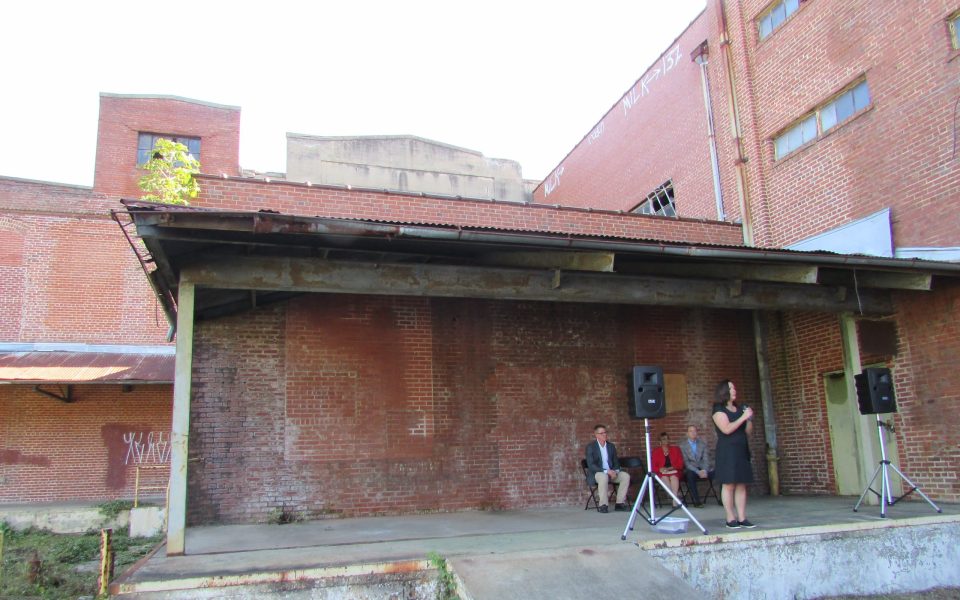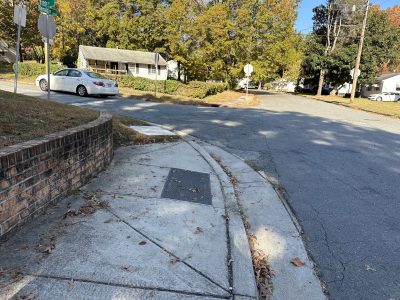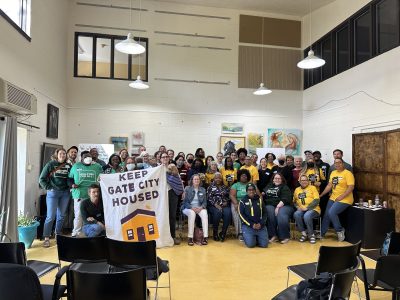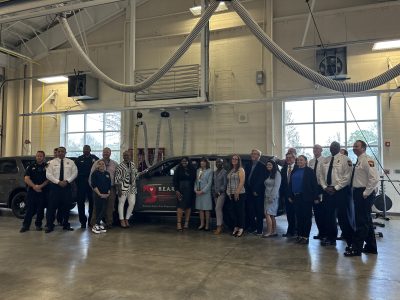The city of Greensboro is supporting a $54 million redevelopment project at Printworks Mill with $1.2 million in funds from a 2016 housing bond, but some question whether the price point for the “affordable” housing is realistic for current residents in District 2.
City Manager David Parrish recalled riding his bike as a child through the neighborhood to the south of the old Printworks Mill, which was derelict even then. He jokingly asked the crowd of developers and city leaders not to tell his mom that he had also played in a nearby section of North Buffalo Creek that remains choked in weeds.
As Parrish concluded, the sound of a car accelerating and then screeching to a halt on nearby Fairview Street provided a comedic audio embellishment to his narration.
“We’ll work on some radar enforcement, too,” Parrish quipped.
The $54 million investment by the Wisconsin-based Alexander Co. to redevelop the iconic 1913 mill helps to fulfill a goal of Councilwoman Goldie Wells, who represents District 2. Wells recalled that when she first ran for city council in 2005 she adopted a slogan of transforming “trash” to “treasure.”
“This is going to be another treasure,” she said.
The Alexander Co. plans to redevelop the derelict mill into 217 apartments, with parking, retail and self-storage space, with completion anticipated in late 2019 and early 2020. Following on the heels of the redevelopment of Revolution Mill — completed in 2017 — the project adds a new component to what the developer and city officials are dubbing a new “Mill District.” Printworks, Revolution and, further downstream, White Oak, were once part of the Cone Mills textile empire, which provided the industrial backbone of the city in the early 20th Century and spawned the mill villages that set the pattern for the working-class residential neighborhoods that remain today.
Repurposing one of the industrial buildings that catalyzed residential development and also gave the area its identity was a motivating factor for the developers and city officials. But for the city, affordable housing was also key. City council approved at $1.2 million grant to the developers in April to support the project. The funds come out of a $25 million housing bond approved by voters in 2016. In exchange for taxpayer support, the developer is setting aside two thirds of the units for affordable housing — defined as people who earn less than 60 percent of area median income. That translates to $681 per month for a one-bedroom apartment, as compared to a market rate of $950, and $817 per month for a two-bedroom unit, as compared to market rate of $1,400.
Wells acknowledged after the groundbreaking on Wednesday that “affordable” can be a relative term.
“When we say it’s affordable, that’s for people who are making a decent salary,” she said. “It won’t be for the working poor.” But she said that, as with Revolution Mill, she expects the redevelopment of the property to benefit the surrounding neighborhoods and her district as a whole.
“I think it should cause property values to go up around it,” Wells said. “We’re always looking for safe neighborhoods. I’m concerned about the way the neighborhood looks. I think it will add to aesthetics.”
Byron Gladden, a member of the Guilford County School Board, observed that the cost of an affordable one-bedroom apartment at the complex will be more than his monthly mortgage. He said he fears that the redevelopment will contribute to gentrification.
“Like Revolution Mill, it’s going to be a beautiful space,” Gladden said. “What is the strategic plan for affordable housing that doesn’t look like a step up from projects?”
Gladden said that with Democrats holding every seat on city council, he would like to see the city pursue redevelopment with a race-conscious approach that analyzes how projects are likely to affect working-class residents of color. Further, he said the city should provide additional subsidies that don’t rely on credit scores because, he said, minorities are historically burdened by bad credit due in part to low levels of financial literacy.
This slideshow requires JavaScript.
Dave Vos, the development and project manager for the Alexander Co., said North Carolina’s state historic tax credit and a matching federal historic tax credit, made Printworks Mill an attractive investment. The State Historic Preservation Office provided Alexander Co. with a list of mill properties across the state.
“Most are in outlying areas, so they don’t really have the population to support redevelopment,” Vos said. “We were excited to find a building like this close to shopping, close to jobs, and close to other redevelopment. It was like a diamond in the rough.”
City officials got a chance to peek inside the building. The cavernous interior, with graffiti-covered walls illuminated by temporary lighting, suggested a shadowy, cinematic underworld.
Benjamin Briggs, executive director of Preservation Greensboro, said he appreciates the “steampunk” quality of the building.
“I love the whole thing,” he said. “It has these big spaces, big windows, all this concrete.”
His love for the building extends to the graffiti that will inevitably disappear under coats of fresh paint. In addition to bold strokes of some of the gang-inspired pieces, Briggs said he found a mural depicting a western scene in one of the rooms.
“It’s like a Brooklyn art museum,” he said. “We had one guy come in when we were looking at it, and he was telling us the names of the artists. I celebrate the graffiti. It’s layers of sociology. I try to look at it as objectively as possible. I’m intrigued by the art.”
Mayor Nancy Vaughan articulated a different vision for the space.
“We want people to invest more in East Greensboro,” she said before the ribbon-cutting. “Because East Greensboro is a great place to live, work and play. And this is going to be a wonderful place for people to come. And whether they’re going to live here or work here or eat, it will be a new destination.”
Join the First Amendment Society, a membership that goes directly to funding TCB‘s newsroom.
We believe that reporting can save the world.
The TCB First Amendment Society recognizes the vital role of a free, unfettered press with a bundling of local experiences designed to build community, and unique engagements with our newsroom that will help you understand, and shape, local journalism’s critical role in uplifting the people in our cities.
All revenue goes directly into the newsroom as reporters’ salaries and freelance commissions.





Leave a Reply